Studio visit: Eric Vanuytven
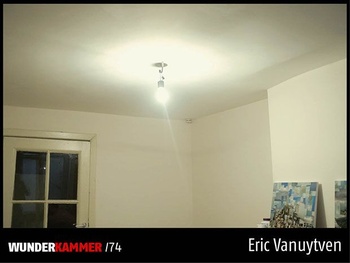
If eyes really are the windows to the soul, you know Eric Vanuytven like the back of your hand. He recently exchanged the streets of Brussels – where he painted frivolous eye-catchers on walls under the pseudonym Erick Hikups – for a studio and pop-up project space in Sint-Gillis/Saint-Gilles. We ignored the injunction and pulled open the doors of Do Not Open.
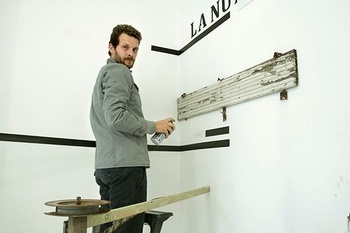
Sitting inside, wedged between four walls, just him and his works, that’s no option for Eric Vanuytven (1980). The talkative and enthusiastic street rat who until recently gave soul to the public areas of Brussels by spray-painting charming, combative, and surprised eyes looking for unexpected encounters on the walls of the city, cannot simply shut off the beat of the street that rushes through his veins. The lyrical and poetic dynamism of the city is too much part of who he is, and the encounters the city facilitates are too important. “Interaction, that was the big idea behind the eyes I painted in the streets. Making a real connection with the environment in a positive way. Those eyes don’t stare at you like Big Brother, that street art cliché, but encounter you openly. They take a step towards the neigbourhood with an invitation to meet me halfway.”

For more than ten years, the centre of Brussels was the unique terrain on which Erick Hikups staged these encounters: “I never painted in Sint-Gillis/Saint-Gilles or Schaarbeek/Schaerbeek, only in the centre of Brussels, every day, for twelve or thirteen years. I also painted illegally, on enormous walls, during the day. I would go and talk to people in the neighbourhood about that wall being rather bare and that I wanted to do something about it. Talking to them influenced my work and I would create something in dialogue with the people. The social nature became so important that I try to translate that into my collages now.” One of the works in Eric Vanuytven’s underground studio displays that social character very explicitly. It is a hectic, varied composition that combines different people and different ages to tell a completely new story. “In a city, you live beside each other, with each other, and opposite each other. My collages aren’t based on one culture or visual culture. My images come from an enormous variety of sources: the 1960s, the 2000s, from Moroccan and American magazines, etc. As a result, a timeline emerges through those images that has no beginning and no end, which is situated in a kind of middle, a constant repetition. People still sit on stones looking at landscapes, they still go to war, and produce too much food, and there is still too much pollution. I try to include that cyclical aspect in my work by talking about the past, present, and future simultaneously.”
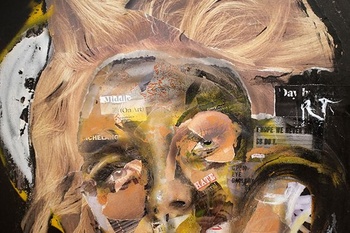
Eric Vanuytven – who was born in Dilbeek, but has lived in Lennik for four years, where he also owns a larger studio – collects the images that form the intuitive building blocks of his stories in Brussels. “As a street artist, you find yourself in places that are not your own. You cannot determine any of the rules beforehand, the place determines the rules. I want to retain that aspect in the work I make now by using found objects. For example, I have boxes and boxes of magazines here, collected in the Marollen/Marolles on the Place du Jeu de Balle. They are all images – I call it our collective visual material, which is accessible to all – that spontaneously stick, which are more found than sought, and from which I can distil stories to tell a new story. I am endlessly fascinated by all those little stories that clash together but form a unity in that bigger, general image.”
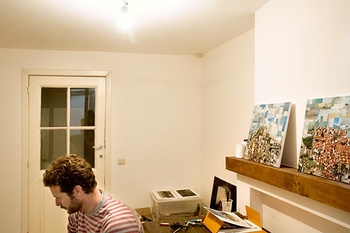
Collage is a technique Eric Vanuytven was already using when he still roamed the streets of Brussels for his murals. “It was a starting point, a sketch, a foundation for my work.” The turn-around came through an invitation from Benjamin Boutin to do something with all those collages in the Do Not Open magazine. “I met Benjamin in September last year. By that point, I had trodden all the possible paths and boundaries of street art and was faced with the choice either to spend years simply reproducing what I had already done, or challenge myself and try something new. I chose the latter and so last February, Benjamin and I launched the Do Not Open pop-up project space. It was a fantastic idea because our interaction and exchange is incredibly inspiring. On the one hand, you challenge artists, who do not naturally use collages, to step outside their familiar environment and look at their work and their universe differently. On the other hand, you yourself are also inspired by those contacts and their work. That was very significant in the process of my transformation. I don’t think I would be making what I’m making now if I hadn’t invested in Do Not Open. We can keep this place until November, and will move in with Recyclart at the end of 2014. We’re still looking at possibilities for the period in between.”
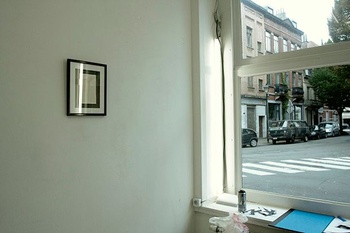
As a newcomer, Do Not Open profiles itself differently than regular galleries. “We don’t work for commercial goals. At the moment, if you have a series of works, you might be able to pick out five that match a gallery concept; five works that will sell. But what about the other five, which are perhaps not as commercially viable, but which are nevertheless just as interesting. Those are the things we want to exhibit too; the things we look for.” But his own, radically transformed artistic practice also remains a search: “That search is precisely why we do it all! And I’m still searching. But it could hardly be otherwise; everything went so quickly. The change from graffiti and later street art to collage, first more portraits and these days more abstract landscapes, basically only took about one year. I am currently doing a lot of experiments with the surfaces on which I work. I’ve made some things on canvas, but for people who started in street art that is still a kind of sanctuary, to which so many expectations are linked that I don’t want to involve in my work. The surface depends on the context and the idea and concept that I want to use in the work. For example, I am using hand-made paper at the moment, and I would like to design things in 3D.”
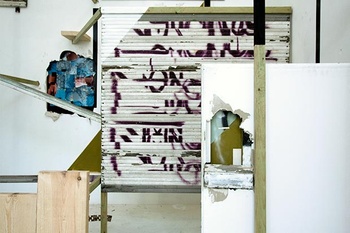
"L'objet", the joint exhibition that the two founders of Do Not Open recently opened in their own space – on the ground floor of the building that houses Eric Vanuytven’s basement studio – demonstrates the promise of that three-dimensional aspect. The collages Eric Vanuytven makes of images – visual snippets – and words – a fragment of an image combined with existing texts that speak a different language when sections are deleted – are given a very logical counterpart in the arrangement of the space. The hole Marcin Dudek kicked in the plasterboard for his exhibition has been incorporated into the structure. In situ work is a language Eric Vanuytven speaks perfectly. “I have always worked in a space. That used to be the city, and I created something in balance with that space. Those experiences have proved very useful. And the practice also symbolises one of the main thrusts of my work: you cannot construct without deconstructing and you cannot deconstruct with constructing. It’s a kind of full cycle that also plays on another level: I start with a collage to make an installation that then recurs as a collage. And that is incredibly easy here: I can go back and forth constantly between upstairs, the exhibition space, and downstairs, my studio.”
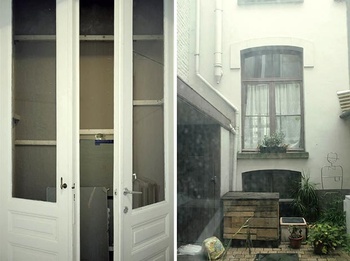
Below ground and above ground, high and low. These are two sides that are of equal importance in Eric Vanuytven's work. "I have always maintained the link between those two schools: contemporary art and graffiti. The one inspires the other. Graffiti is a language, a visual language I’m good at; I speak it. But my language has evolved over the years. Look at it this way: I was raised in Brussels. My parents, my grandparents, everyone is from Brussels. We speak the dialect and the culture is alive in our house, as a result of which my Dutch was never very good. My wife is a speech therapist… (Laughs) She helps me to speak correct Dutch. That doesn’t make me a different person, but I do use different terms, different words. That is similar to what has happened in my work. Street art is part of my vocabulary, but it is so enriched or changed that I also speak the language of the fine arts now. People often think of street art as a ghetto: 'Those people come from off the street, what on earth are they doing in a gallery?’ But if as an artist you leave street art behind and just start creating, you realise very quickly how wafer-thin that line is. The most important thing is that you are honest about what you do and in the work that you make. Viewers notice that. That’s why I like to say loud and clear that I come from an artistic discipline that is considered vandalism, and now make work that is considered elevated. I like the contrast of that dichotomy between upper and lower ground. In my experience, one cannot exist without the other. There’s that full cycle again! And all together, that has led me to make what I’m making now."
Borough: Sint-Gillis/Saint-Gilles
Do Not Open: Albaniëstraat 47 rue d'Albanie, Sint-Gillis/Saint-Gilles, www.donotopen.org
Exhibition: > 10/11, 24/24 (10/11, 14 > 19.00: finissage & open studio), “L'objet” (together with Benjamin Boutin), Do Not Open
In situ installation: 27 > 29/11, “Together”, Westrand, Kamerijklaan 46, Dilbeek, www.westrand.be
Info: eric-van-uytven-blog.tumblr.com, www.facebook.com/ArtOfErickHikups
Photos © Heleen Rodiers
Borough: Sint-Gillis/Saint-Gilles
Do Not Open: Albaniëstraat 47 rue d'Albanie, Sint-Gillis/Saint-Gilles, www.donotopen.org
Exhibition: > 10/11, 24/24 (10/11, 14 > 19.00: finissage & open studio), “L'objet” (together with Benjamin Boutin), Do Not Open
In situ installation: 27 > 29/11, “Together”, Westrand, Kamerijklaan 46, Dilbeek, www.westrand.be
Info: eric-van-uytven-blog.tumblr.com, www.facebook.com/ArtOfErickHikups
Photos © Heleen Rodiers
Read more about: Expo
Fijn dat je wil reageren. Wie reageert, gaat akkoord met onze huisregels. Hoe reageren via Disqus? Een woordje uitleg.